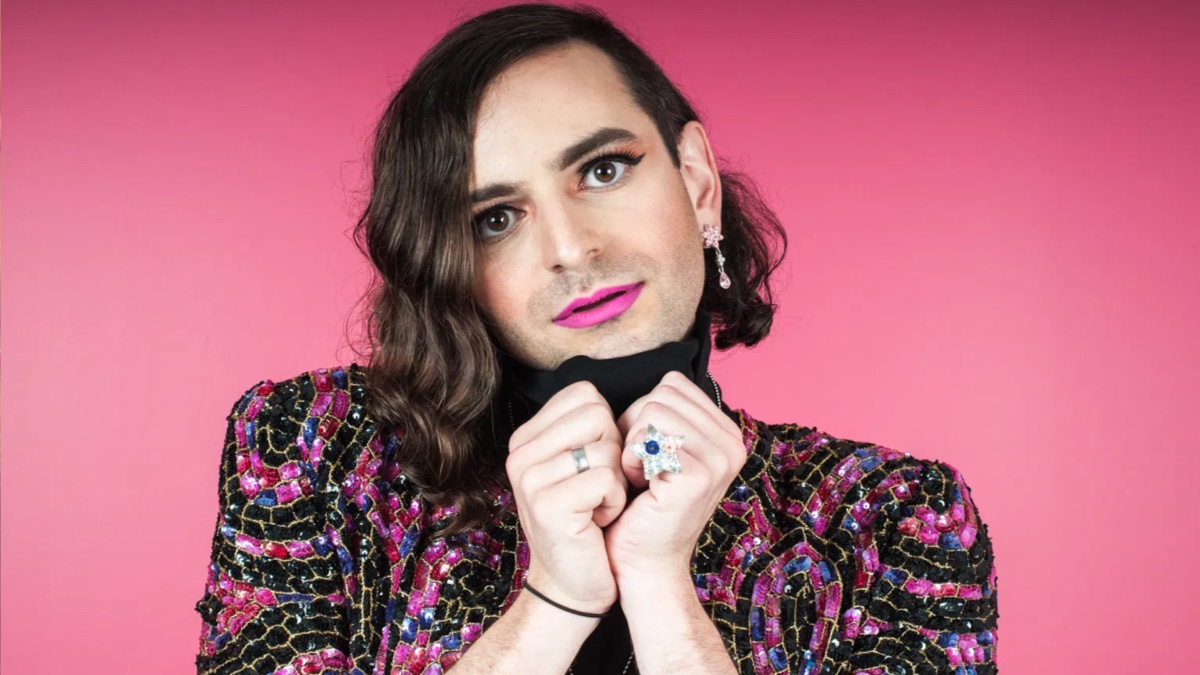
10 Artworks That Explore Queer Issues and Identity
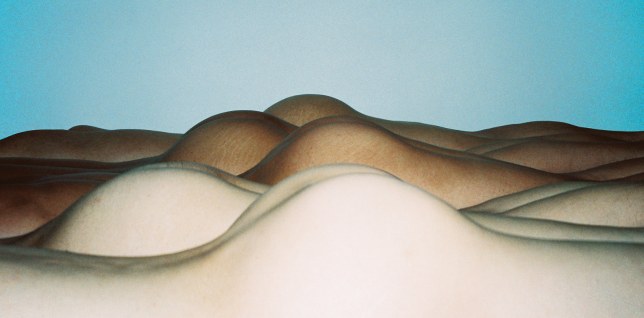
Gender is one of those issues where terminology never feels quite right. It’s either a few decades behind the times or too subjective to fit into simplified, generalized categories. And when words fail to fulfill their raison d’être, the messages we seek can be found in art and its visual vocabulary. With this selection of artworks, Artsper is considering identity in all of its forms. From LGBT art to other, beautifully complex manifestations of queerness… Ready to discover our gender-bending favorites?
1. Ricky Cohete: Men and Boots, 2017
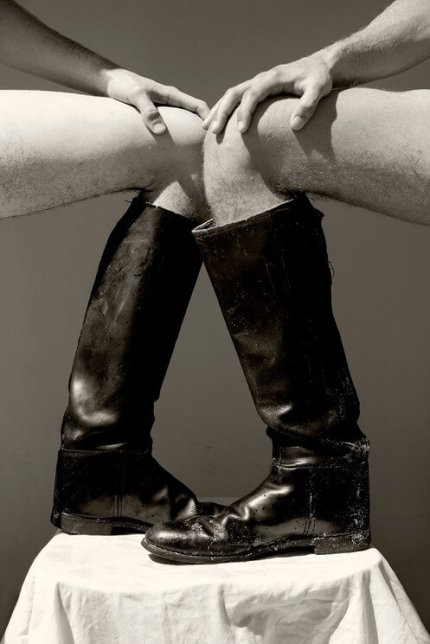
Miami-based photographer Ricky Cohete has mastered the male form, reviving the composition and grace that was once reserved to ancient Greek sculptors. The self-taught artist first approached the medium by shooting Miami’s ballet dancers outside of their “safe” and familiar rehearsal spaces. From that point on, Cohete cultivated a unique aesthetic, playing with the multiple iterations of the male form. In a work like Men and Boots, he uses both feminine and masculine energies to offer a unique perspective on gender roles and how they shape our identity.
2. Charlotte Abramow, Autokiff, 2019
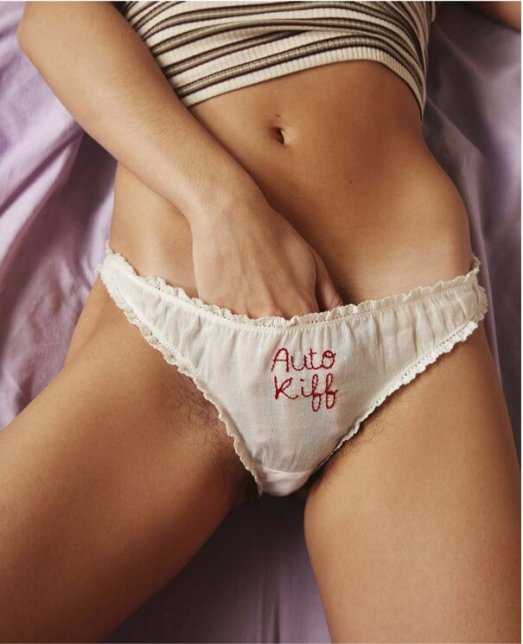
Straight out of French slang, “Auto-kiff” is a cool, informal expression designating self-pleasure. As the stray hairs in this photograph may suggest, the artist is no stranger to feminism and its discontents. Charlotte Abramow has placed gender at the center of her work, using it both as a means of empowerment and humor. When considering LGBT art, we often forget that sexuality need not always be partner-focused. As with most things, it begins with the self and often requires a good deal of introspection and self-exploration. Charlotte Abramow’s witty and aesthetic works will surely help along the way!
3. Juan Boilero, La Miranda, 2021
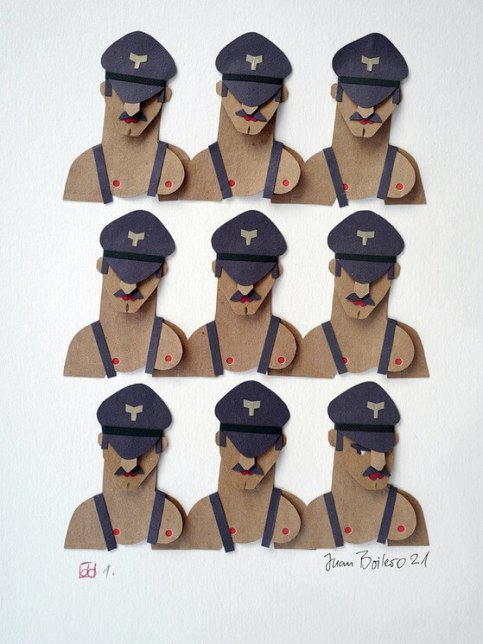
Ever wonder what you could do with scissors and some cardboard? Cuban artist Juan Boilero has made an art of it. He uses découpage to offer us playful and proud representations of male sexuality. The repetitiveness within his work only makes it that much better. Taunting the viewer, one must search to discover the small discrepancy within the pattern. Usually at the bottom right corner, the figure will subtly alternate. It’s almost as if the artist is winking at the viewer. In La Miranda, the slight lifting of the hat reveals one of the figure’s charged glances. The anonymity, the uniformity begins to fade and we come to see the individual within the crowd.
4. Frida Kahlo, Self-Portrait with Cropped Hair, 1940
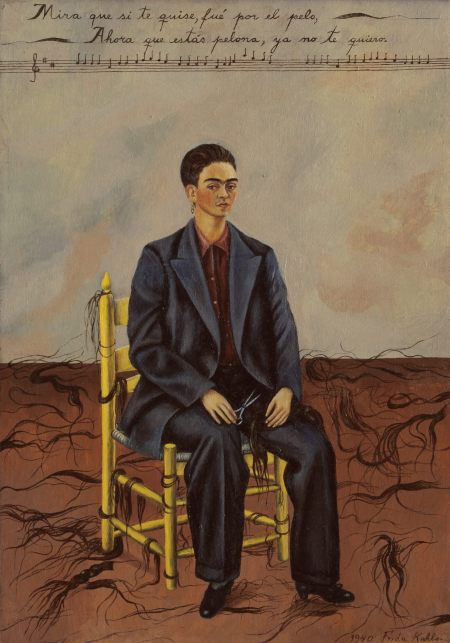
Although it is said often, it bears repeating: Frida Kahlo was undoubtedly ahead of her time. This self-portrait dating from 1940 is only a testament to that effect, bringing us one of the first true examples of LGBT art. Below a few lines of text and music, we find the artist seated in a chair, surrounded by the locks of her freshly-cut hair. Scissors in hand, her expression is one of calmed assurance and not unmitigated despair in light of her shedded femininity. This symbol of womanhood, which many cling to in order to signal and assert their gender, is confidently cast aside by Frida Kahlo, already embracing the masculine aspects of herself through her choice of dress. The artist famously defended that we each carry both masculine and femnine qualities, encouraging us to face this plurality instead of denying it.
5. Lídia Vives, The Rival, 2015
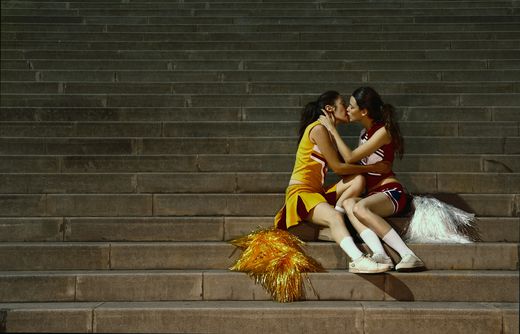
With The Rivals, Barcelona-based photographer Lídia Vives captures a fundamental aspect of same-sex and non-heteronormative relationships: the comradery. The uniforms in this photograph accentuate the similarities between the two subjects. However, if one takes a closer look, it quickly becomes apparent that they are wearing different colors, and thus belong to different teams. This detail encapsulates the complexities of being queer, and having to navigate the space between friendship and romance, sisterhood and binary gender roles.
The photograph also evokes the complicated relationship that exists between sexuality and sports. Whether it’s cheerleaders or football players, these spaces are determined by their rigor and physical excellence. Although they’ve been unwelcoming to non-conforming gendered athletes in the past, we’ve seen that representation can go a long way… especially when it’s in the form of a beautifully composed photograph.
6. Robert Mapplethorpe, Two Men Dancing, 1984

Robert Mapplethorpe, Two Men Dancing, 1984
No one has mastered dualities with quite the same genius as Robert Mapplethorpe. The film photographer famously began his career alongside Chelsea Hotel-legend Patti Smith. With his medium-format Hasselblad in hand, he perfected the art of playing with binaries, pushing them until they reach their limit. His black and white photographs are full of contrast, on both a technical, aesthetic level but also in terms of his chosen subject matter. With Two Men Dancing, we see the dichotomy between masculine and feminine assert itself, juxtaposing the hard and the gentle. As a part of New York’s S&M scene during the late 70s, Mapplethorpe’s images often went a step further, exploring the relationship between dominant and submissive, purity and “immorality,” censorship and freedom….
7. Bill T. Jones Body Painting by Keith Haring (with Tseng Kwong Chi), 1983

Keith Haring (in collaboration with Tseng Kwong Chi) Bill T. Jones Body Painting by Keith Haring (Image G), 1983
Keith Haring’s body paintings followed the artist’s long-standing tradition of avoiding canvases and seeking uncharted artistic territories. Beginning with his subway sketches, Haring wasn’t afraid to take art outside of its formal context, eventually bringing him to paint the subjects themselves. These art performances varied, featuring stars like Grace Jones and Robert Mapplethorpe, and were oftentimes captured on film. The photograph of Bill T. Jones from 1983 was done in collaboration with photographer Tseng Kwong Chi. The B&W images have eternalized quite a spectacular moment: the meeting of three artists, combining photography, choreography and street art.
As a famous dancer and choreographer, Bill T. Jones expressed the link between art and identity throughout his career. In this case, the expressivity of dance is in conjunction with another type of expression, namely Haring’s singular and enigmatic hieroglyphs. This particular time period and its artists paved the way for what queer art has come to mean today.
8. Javier Rey, Amorphisms 7, 2016

In his series “Amorfismos” or Amorphisms, Javier Rey explores the distorted, negative images we have of ourselves. “I recognize the body as an uncomfortable and changing mass, as an object that I inhabit and deteriorates with use, a weight that I have to drag like something alien and annoying,” shares the artist. As a result, this project aims to represent the mental images we have of ourselves, transforming them into concrete, shared realities. With the work titled Amorphisms 7, we can recognize the physical indicators of negative self-image and shame, as the figures hunch and curve into themselves.
Across this series, different couples lock together, becoming one. Rey does this with the intention of using photography as a starting point, allowing him “to explore my self-image and reconstruct it, resulting in a mass of skins that clump together in space.”
9. Tracey Emin, Her Soft Lips Touched Mine and Every Thing Became Hard, 2008
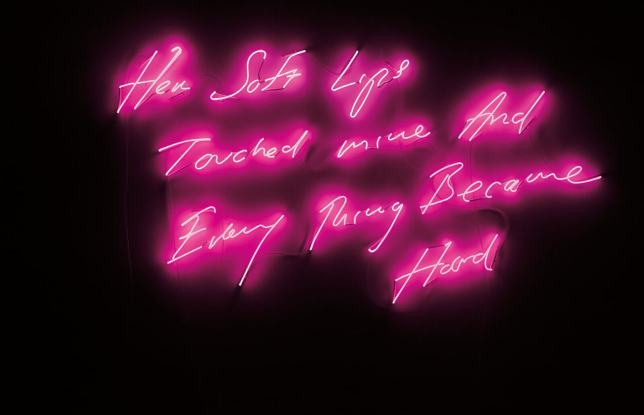
Tracey Emin, Her Soft Lips Touched Mine and Every Thing Became Hard, 2008
British artist Tracey Emin’s works are widely recognized as autobiographical, stemming from her personal experiences with controversy and trauma. The artist has used her private life throughout her career, whether it be the polemic Everyone I Ever Slept With installation or the love letters she’s published since. Emin’s neon transcriptions, which mimic her own handwriting, are no exception. They remain intimate and deeply personal, capturing fleeting thoughts or unspoken desires. The message in this piece, titled Her Soft Lips Touched Mine and Every Thing Became Hard, is one of many. Another enigmatic example of LGBT art is the neon-written: “I Loved You Like a Distant Star.” Although these artworks aren’t as visual as they are thought-provoking, they continue within this tradition of unabashedly representing open, avowed modern love.
Her confessional works have had an important impact on the art world, normalizing feminist narratives and opening paths for unconvential, trauma-inflected experiences. Tracey Emin’s approach continues to disorient many, continuously questioning the institutions and conventions that maintain the status quo.
10. Gilbert and George, George the Cunt and Gilbert the Shit, 1969
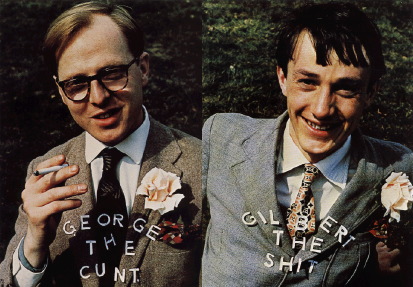
The famous art duo Gilbert & George first met as students at Saint Martin’s School of Art in London. They have been working in collaboration ever since, known for their trademark suits and self-reflexive, ‘living sculpture’ approach to performance art. As one of their very first works together, George the Cunt and Gilbert the Shit symbolizes the couple’s humor and anti-elitist approach to art. The self-imposed designations were meant to preceed the anticipated critique they would receive from the art world and its reviews. The expectations expressed by the couple’s self-portrait from 1969 weren’t entirely off base. Later on, Gilbert & George would come to face a great deal of criticism for their chosen subject matter.
With nudity and explicit sexual acts at the center of their work, Gilbert & George certainly redefined the extent to which sexuality could be explored within formal, artistic settings. However, the artists have met a great deal of contention with regards to their political stance and continuous defense of conservatism. When discussing these issues, Gilbert & George claim that it is important to fight hegemony at all levels, especially when it comes to public thought.
Queer and LGBT Art to come…
No matter what form it takes, queer and LGBT art is particularly powerful and boundary-pushing. From photography to body painting, neon art to découpage, various mediums have captivated LGBT artists whose creative potential is truly endless. If you’re still eager to discover the ways gender and sexuality can influence the art world, there’s no need to worry! Discover the top 5 Trans artists taking over the art scene with Artsper…

About Artsper
Founded in 2013, Artsper is an online marketplace for contemporary art. Partnering with 1,800 professional art galleries around the world, it makes discovering and acquiring art accessible to all.
Learn more











